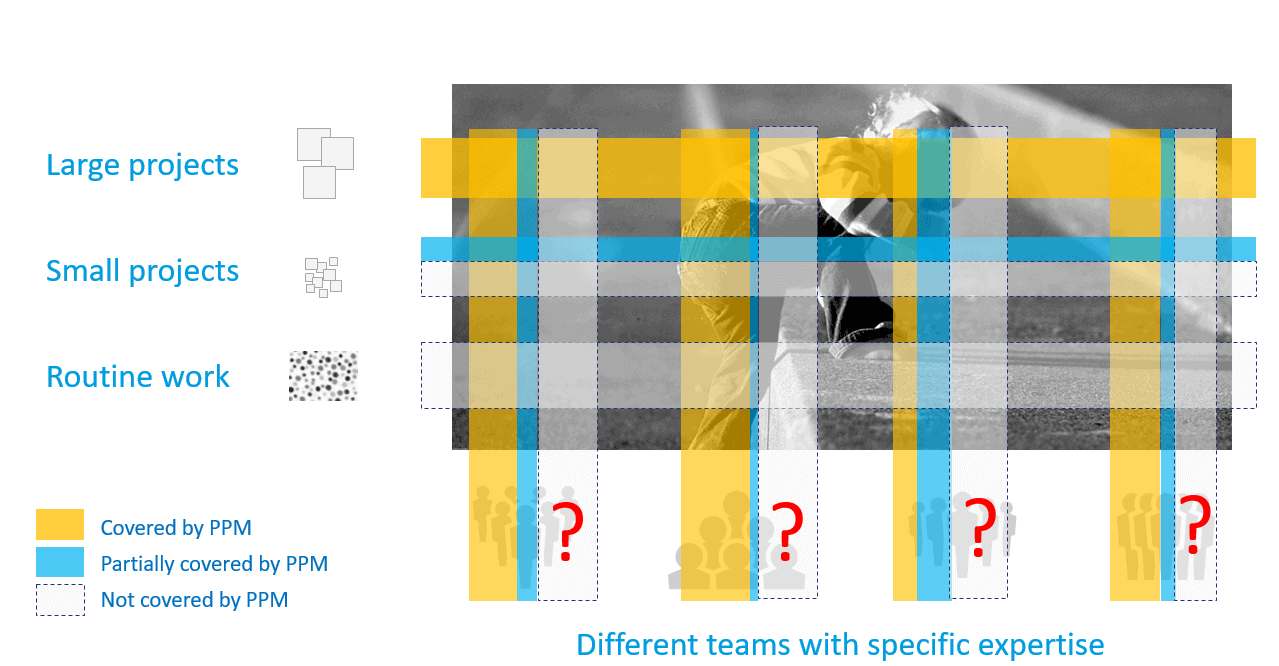
The marketing and the truth about project portfolio implementations
What is PPM software?
I recently stumbled upon a very interesting blog by Vilmos Rajda. He was a believer of the magic bullet of project portfolio management that sales people promised it to be. But after years of experience, he came out a little disillusioned. In his blog, he describes the most common assumptions that PPM vendors would not tell you—or would downplay in their sales literature. Paying attention to these assumptions can make the difference in successfully delivering business value. Recently, we won a project to implement Binocs for a large, 800-plus person strong R&D department. For years, they drove a full-featured top-notch PPM. They have trained staff to support the PPM processes, and there is full top management support. But why doesn’t it work? “It’s only that we miss…,” and what follows are exactly the arguments by Rajda. This customer found in Binocs what was needed to ease the PPM processes.
I’ll give you my 2 cents on how Binocs approaches resource planning differently than the PPM software packages currently on the market.
Assumption 1: Everything You Do Is a Project
According to Rajda
Most organizations operate in some shade of matrix structure. There will be employees who share their time between project and operational activities. This creates exceptions in the PPM application.
Our approach
Knowledge workers deploy their expertise in a cocktail of larger and smaller projects, shaken with routine tasks and ad hoc requests. It’s a nervous maze in which project managers, demand managers and functional team leaders fight to get things done. In Binocs, we plan projects AND routine work. In fact, all demand—coming from anywhere and everywhere—is gathered under one roof, no exceptions. That way, you have a complete picture of your resource needs and not only the project part. Here lies a big difference with the PPM software. PPM software satisfies the needs of project managers, where Binocs gives answers to project managers AND resource managers. Both project managers and resource managers have a complete view on their capacity needs and capacity issues.
Assumption 2: Project Managers Have Unlimited Time to Track Project Minutia
According to Rajda
If project managers (PM) spend their time continuously entering up-to-the-minute schedules, budgets, risks, issues, resources, timesheets and status into the PPM tool, then you will achieve real-time data. But at what expense?
Our vision
Resource planning is a collaborative process. There’s not a handful of project managers that can handle this alone. PPM software is specifically built for project managers. It’s a cockpit full of buttons and functionality for project managers who are specifically trained to use it and for whom a large part of their job is to understand and work in the PPM software. In life, everybody—project managers, demand managers and team leaders—have a piece of the puzzle. But a lot of these people have different missions than trying to understand the complexities and workings of PPM software.
Our approach
Binocs approaches this by adopting a user centric approach. Binocs is as low threshold it can be, easy to use and we aim for minimal input. Using Binocs must be as simple as driving a car. That way, everybody—not only the project managers—can use it. They are all contributing to better resource planning. We leave “flying the PPM plane” for dedicated and trained pilots. But as the input is there, they’ll have time to prepare and drive true portfolio decisions.
Assumption 3: Project Parameters Are Facts
According to Rajda
When a project is initiated, most of the parameters (costs, timelines) are order of magnitude estimates based on anecdotal evidence. But it’s not because we enter this into a PPM software, with two decimal places, that they automatically become facts.
Our experience
In PPM software, projects are estimated by the project managers. They estimate, based on the work they foresee, how much time they’ll need for specific resources. But what we have seen, time and time again, is that they’re not always equipped to make the best estimates.
Our approach
In Binocs, the teams performing the work make the estimations. But they don’t do it on an ad hoc basis. The teams standardize the services they perform as building blocks, creating a list of services they perform. Their estimations are configured in Binocs, and demand and project managers choose from this service list. Does this mean these estimations are always 100% correct? Absolutely not. But experience has taught us that approaching it this way is much better than ad hoc estimations by the project managers. And yes, we know when reality kicks in, a service is not always performed in exactly the same timeframe. But that’s OK. Because when you look at it from a team perspective, receiving service requests from different channels, the sum of requested workload gives a pretty accurate picture, which can serve as a basis for capacity and resource planning.
Assumption 4: Companies Have Mature Processes
According to Rajda
Most of them don’t. If not careful, you will be implementing advanced project management techniques with diminishing value. PPM software requires quite rigid processes to be set up and only start showing value when everything is set in place.
Our approach
We specifically designed Binocs to use it gradually. Binocs grows with you and your processes. Typically, after four weeks, we are already doing our first analyses based on data in Binocs. Then, the refining starts based on new processes we define and install step by step.
Does this mean we don’t need PPM software anymore?
Now, I didn’t say PPM software (and the processes involved) don’t serve a purpose. There are a lot of things the project managers and managers can benefit from PPM software. But when talking about resource planning, they need a less complex and more collaborative approach. That’s where Binocs kicks in. What we’ve seen at different clients is that Binocs can work together seamlessly with existing PPM systems. The PPM software answers to the needs of the project managers to define the financial goals, prioritization and revenue estimations. Binocs helps to plan the resources to realize these goals, collaboratively.




